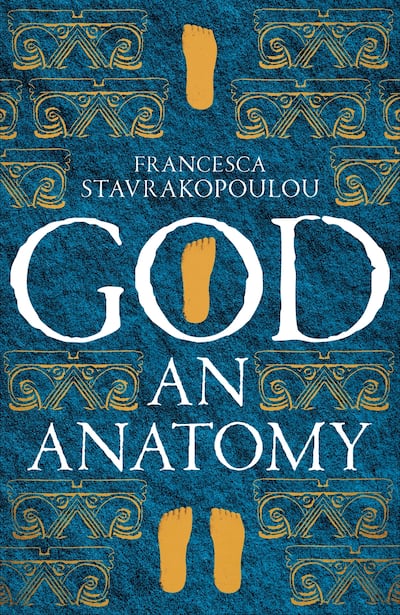Even if you don’t believe in God you will probably have an image of him – or her, or it. A big head, piercing eyes and a pointed finger normally feature.
But where do these impressions originate, and do they tally with descriptions of God in the Bible? Francesca Stavrakopoulou investigates this question in her new book God: An Anatomy (Picador).
In a delightfully original and no-nonsense approach, she relies on the closest thing to evidence: ancient scripture, including eye-witness accounts from the Old and New Testaments. The God that emerges is “a supersized, human-shaped body with male features and shining, ruddy-red skin, tinged with the smell of rain clouds and incense”, she writes.
I think these biblical writers – ancient Israelite writers – were much more comfortable with bodily language for God
Stavrakopoulou is an unusual biblical scholar. She is a professor specialising in the Hebrew Bible and ancient religion at University of Exeter, England, as well as being an atheist. And she takes to the problem as if it was an exercise in natural history, scrutinising her subject from head to toe – leaving nothing out.
(Yes, there’s a chapter on the divine groin that includes a sighting from Ezekiel – “not the only biblical figure to acknowledge God’s genitals”.)
The project had been in the back of her mind since she was a student of theology at university. “There was a broad assumption among lecturers and students alike that the God of the Bible is without a body,” she says.

“But as I looked closely at the books comprising the Bible, I couldn’t find this bodiless God. Instead, these ancient texts conjured a startlingly corporeal image.”
When she challenged a professor about this, she was told not to take the descriptions too literally. "Apparently, we had to look not just at the texts but through the texts, to engage their theological truths." But it was hard not to detect a cop-out.
Stavrakopoulou explains further as this week’s Unthinkable guest.
Descriptions of God seem to be more vivid in the earliest books of the Bible and then decline over time.
Francesca Stavrakopoulou: “Yes, I think these biblical writers – ancient Israelite writers – were much more comfortable with bodily language for God. It’s partly because it came out of a religious culture in which it was normative to think of the gods as having human bodies and it came out of a culture in which some ancient worshippers of this deity did use human-shape figurines, and statues of god, in their rituals.
“But even later writers, from the second half of the first millennium BC, once they get more theologically uncomfortable about the idea [of God having a body], they are still drawing on that same language because it is so deeply ingrained in the way they conceive of divine beings.”
If you looked only at descriptions of God in the New Testament would you have much to go on?
“You still get glimpses of this deity being understood as a bodily God. You still get descriptions of him sitting on a throne in the heavens – with a hand, and a head, and a face, and feet. You still get those references and allusions, partly because they are recycling much older traditions, and partly because, if these early writers want to claim you can have a social relationship with this transcendent deity, one of the best ways – or most effective ways – to communicate the intimacy of that relationship is to cast it in very human terms.
“So even though philosophically a lot of early theologians were arguing, ‘No of course, God the Father doesn’t have a body’ that was not the case for the majority of early Christians; they would still have perceived this God as having not only human-like characteristics but also human-like body parts.”
The earlier God seems more of a macho, Alpha male, and not a very bookish character. Is that fair to say?
“He is sometimes. I think we have this false dichotomy that the God of the Old Testament is this violent bastard, and the God of the New Testament is this kind of fluffy, loving father. But the God of the New Testament is just as violent as the God of the Old Testament. If you read that stuff in Revelation about killing people it’s the same kind of violence.”
You highlight some very troubling passages that are bound up with conceptions of God’s physique, including God’s apparent condoning of rape in certain scripture. What does this tell us about those who compiled the biblical texts?
“I think we need to place those passages in their political and imperial context. Those passages are talking about imaging God’s wife as the nations who have been defeated by various imperial powers but they are being blamed for it; it’s their fault. God is punishing them for their unfaithfulness to him and that religious unfaithfulness is cast in bodily terms as sexual infidelity.
“But these texts were also written by very small groups of very inward-looking scribal elites who were mostly men, and they were writing for men, and they were writing about men. So I think there was a huge amount of misogyny in those ancient cultures as there was in the New Testament context. It’s about power, and this very masculine idea of imposing masculine power over feminine, which is cast as weaker, other and somehow deviant.”
What do you say to people who believe in a loving God. Can that God be found in the Bible?
“Oh yeah, all the way through, from Genesis to Revelation. When we look at passages where God behaves very violently or misogynistic that’s all framed theologically as a God who loves his people so much that this is what he is driven to do… It’s all framed within love. This is a God who loved so much that he gave his own son to die.”
You wouldn’t see your research as a threat to faith then, but more as an invitation to reflect?
“Yes, and I think the Bible itself allows for contradiction. The fact that we have four different versions of the gospels shows that these ancient writers, compilers were very comfortable with the idea of contradiction and difference and difficulty. And I think perhaps modern readers need to be a bit more [willing] to wrestle with those uncomfortable things in their own texts.”
***
Ask a sage:
How do we know if God exists?
William of Ockham replies: “God exists in such a manner that He cannot not exist.”














